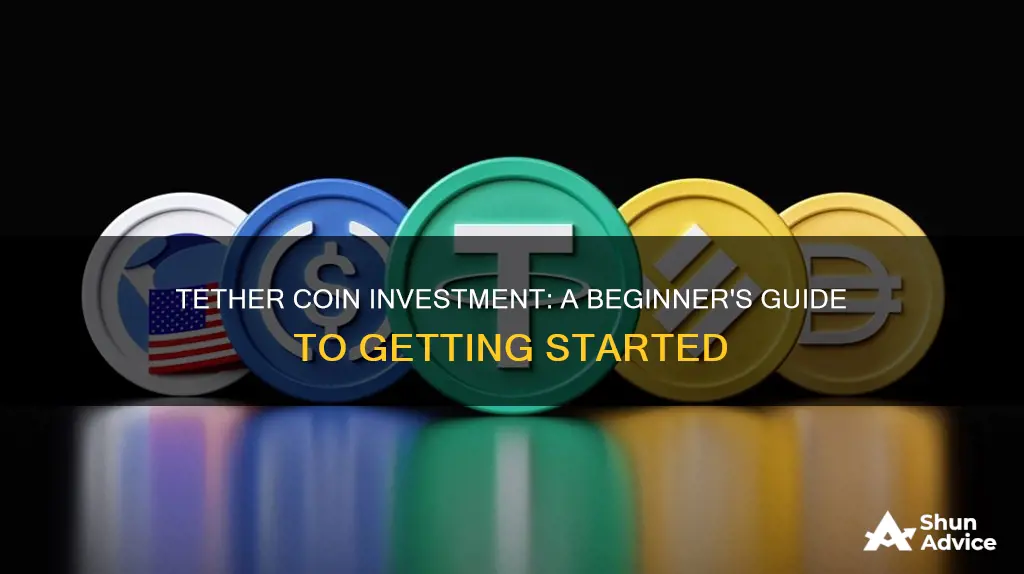
Tether (USDT) is a cryptocurrency pegged to the U.S. dollar, also known as a stablecoin. It is intended to have an equal value, with 1 Tether being worth $1. Tether is a less volatile and therefore safer option for first-time crypto investors. It can be purchased through a crypto exchange or app using platforms such as Binance, Kraken, or Coinbase. This paragraph will explore the key facts about Tether and how to invest in this cryptocurrency.
| Characteristics | Values |
|---|---|
| Type of Cryptocurrency | Stablecoin |
| Pegged to | U.S. Dollar |
| Tied to | Fiat currency |
| Value | 1 USDT = 1 USD |
| Purpose | Medium of exchange, mode of storage of value |
| Use Cases | Purchasing crypto, money transfers, earning interest |
| Purchase Options | Crypto exchange or app (Kraken, Coinbase, Binance, etc.) |
| Wallet Options | Hot wallets, cold wallets, semi-hot wallets |
What You'll Learn

How to buy Tether (USDT)
Tether (USDT) is a stablecoin that aims to maintain a value equivalent to the US dollar. Each USDT is redeemable for $1, though its value may fluctuate. It is the most widely used stablecoin and the largest by market capitalization.
Choose a Crypto Exchange:
Select a trusted global exchange like Binance, Coinbase, Kraken, or MoonPay. Compare the fees and complexity of different exchanges before choosing one.
Create an Account:
On your chosen platform, create an account by signing up with your email and phone number. You may also need to provide additional information, such as your name, date of birth, country of residence, and proof of address to verify your identity.
Add a Payment Method:
Connect a payment method to your account. You can use a bank account, debit/credit card, or initiate a wire transfer. Some platforms, like Binance, also allow the use of Google Pay or Apple Pay.
Buy Tether (USDT):
On the exchange platform, search for Tether or USDT. Specify the amount you want to spend in your local currency, and the platform will convert it to the equivalent amount of Tether. Review the details of your purchase, including any applicable fees, and confirm the transaction.
Store Your Tether:
Once you have purchased Tether, consider storing it in a secure crypto wallet. There are several types of wallets, including hardware wallets (e.g., Ledger, Prokey), paper wallets (non-custodial cold storage), and software wallets (e.g., Exodus). You can also store your USDT directly in the wallet provided by some exchange platforms, such as Binance and Kraken, but it is generally recommended to separate your holdings into multiple wallets for added security.
Remember that purchasing any cryptocurrency carries risks, and you should do your own research before investing.
Why Ripple Could Be a Better Investment Than Bitcoin
You may want to see also

Tether's advantages and disadvantages
Tether (USDT) is a cryptocurrency pegged to the US dollar, making it a stablecoin. One Tether token is always worth one US dollar. Here are some advantages and disadvantages of investing in Tether:
Advantages
- Tether is easy to purchase and sell, and is available wherever you normally buy cryptocurrencies.
- Tether can be used as a dollar replacement, eliminating the need to move money through a bank.
- Tether is a good option if you feel that investing in the stock market is risky.
- Tether is less volatile than other major cryptocurrencies.
- Tether can be used for purchasing other cryptocurrencies, money transfers, or earning interest.
- Tether can be sent anywhere globally much more quickly and with lower fees than transfers at traditional banks and financial institutions.
Disadvantages
- Tether Limited, the company that issues Tether, has a controversial reputation due to issues with transparency, trustworthiness, and allegations of manipulating the market.
- Tether's price has occasionally fluctuated from $1, and there is no guarantee that the Tether you buy will be redeemable for $1.
- Tether may not be a good long-term investment since its value rarely moves from $1.
- Tether has been implicated in controversies and legal issues, including a lawsuit for an alleged cover-up related to the crypto exchange Bitfinex.
Mark Cuban's Dogecoin Bet: Millions Invested
You may want to see also

Tether's history and controversies
Tether (USDT) is a stablecoin, a cryptocurrency pegged to the US dollar. It was introduced in 2014 as Realcoin, with the first tokens distributed in 2015 on the Bitcoin network. It was one of the earliest and most successful stablecoins, and its technological innovation was bolstered by a roster of reputable founders, including Bitcoin Foundation director Brock Pierce.
However, Tether has been embroiled in several controversies and legal challenges over the years, including:
- Bitfinex: Tether and Bitfinex, a cryptocurrency exchange, shared the same CEO and CFO and identical executive structures. Tether was listed on the Bitfinex exchange, leading to early success, but this connection also brought scrutiny.
- Bitcoin pump: There were allegations that Tether was being artificially pumped into the market to create liquidity, driving Bitcoin's bull run to $20,000.
- The 2017 hack: About $31 million of Tether was stolen in a 2017 hack, forcing the company to create a hard fork.
- USD-backing controversy: An audit of its dollar reserves that was supposed to happen in 2017 never took place, and Tether instead parted ways with the auditors. This raised concerns about the company's transparency and the extent to which its coins are backed by US dollars.
- Hiding losses: In 2019, the New York Attorney General accused Tether's parent company of hiding an $850 million loss by dipping into Tether's currency reserves. Tether settled the case, agreeing to pay an $18.5 million fine, but it did not admit any wrongdoing.
- Antitrust accusations: A class-action lawsuit filed in June 2020 accused Tether of manipulating the markets by issuing USDT without dollar backing and then selling it to Bitfinex.
- Reserves controversy: In October 2021, a former banker with Tether alleged that company executives had invested reserve funds. There was also evidence that Tether had made billions of dollars in short-term loans to large Chinese companies and crypto companies, secured with bitcoin. While Tether denied these claims, it did not confirm that it held the roughly $69 billion required to back all the coins in circulation.
- Sell-off amid terraUSD de-pegging: When competing stablecoin terraUSD dropped below 30 cents, nervous investors withdrew $3 billion in Tether, causing concern among regulators about the lack of protection for investors.
Despite these controversies, Tether remains a dominant stablecoin and an important tool for traders and investors looking to move in and out of volatile cryptocurrencies. However, its issues with transparency and ongoing regulatory scrutiny have led to continued controversy and legal challenges.
Dusk Coin: A Smart Investment Decision?
You may want to see also

How to store Tether
Tether (USDT) is a cryptocurrency that is pegged to the U.S. dollar, also known as a stablecoin. This means that its value is guaranteed by Tether to remain at a 1:1 ratio with the U.S. dollar. As a result, USDT is protected from the famously high volatility of the crypto markets, where currencies can rise or fall by 10-20% in a single day. This makes USDT a safe haven for crypto investors.
There are a few options for storing your Tether coins:
Storing Tether on a Cryptocurrency Exchange
You can store your Tether coins on the exchange where you purchased them, such as Binance, Coinbase, or Kraken. This is a convenient option as it allows you to easily trade your Tether for other cryptocurrencies or fiat currencies. However, it is important to note that storing your coins on an exchange puts you at risk of losing them if the exchange is hacked or goes out of business.
Storing Tether in a Crypto Wallet
You can also store your Tether coins in a cryptocurrency wallet. This can be a hot wallet, which is connected to the internet, or a cold wallet, which is not. Hot wallets are more convenient and allow you to easily access and spend your coins, but they are less secure than cold wallets. Cold wallets, such as hardware wallets or paper wallets, are considered more secure for storing large amounts of coins as they are not connected to the internet and are therefore less vulnerable to hacking attempts.
Storing Tether in a Bank Account
Finally, you can store your Tether by converting it back into fiat currency and depositing it into your bank account. This option provides more security than keeping your coins on an exchange, as your money is protected by the banking system and FDIC insurance. However, it can be a less convenient option if you plan to actively trade or spend your Tether, as you will need to transfer it back to an exchange or wallet first.
When deciding how to store your Tether, it is important to consider your personal needs for security, convenience, and accessibility. It is also a good idea to diversify your storage methods to reduce risk, such as by keeping a small amount of Tether in a hot wallet for everyday use and the rest in a cold wallet or bank account for long-term storage.
Skycoin Investment: Is It a Smart Move?
You may want to see also

How Tether compares to other cryptocurrencies
Tether (USDT) is a stablecoin, which means it is a cryptocurrency that is pegged to the U.S. dollar (USD). One Tether token is always intended to be worth 1 USD, and it is backed by Tether's dollar reserves. This makes Tether very different from other cryptocurrencies, which are known for their volatility.
Tether's price stability makes it a popular intermediary coin for investors who want to store a stablecoin in their wallets between trading sessions. It is also used for purchasing other cryptocurrencies, money transfers, and earning interest.
Tether is also unique in that it is highly liquid, with low fees, and is widely accepted on exchanges. It is the largest stablecoin by market capitalization and the largest cryptocurrency in terms of trading volume.
However, Tether has faced controversy and legal issues due to a lack of transparency and verifiability of its claimed fiat reserves. There have also been allegations of price manipulation and connections to illegal activities.
In summary, Tether offers stability, liquidity, and ease of use that other cryptocurrencies often do not provide. However, it is important to carefully consider the risks and controversies associated with Tether before investing.
Bitcoin Investment in India: Best Options
You may want to see also
Frequently asked questions
Tether (USDT) is a cryptocurrency that is pegged to the U.S. dollar. It is a stablecoin, which means its price is tied to an underlying asset—in this case, 1 Tether token is intended to be worth $1.
You can buy Tether on most major cryptocurrency exchanges, such as Binance, Kraken, or Coinbase. First, you will need to open an account with a broker that supports the coin. Then, you will need to choose a wallet—either hot storage (a digital wallet connected to the internet) or cold storage (a physical device that holds your cryptos offline). After that, you can place your first order to buy Tether.
Tether is a stablecoin, so its price doesn't fluctuate as much as other cryptocurrencies. This makes it a good option for investors who want to avoid the volatility of the crypto market. However, because its price doesn't fluctuate much, it's not a cryptocurrency that you buy and hold in hopes of the price going up. Instead, it's often used as an intermediary cryptocurrency for investors who want to store a stablecoin in their wallets between trading sessions.







